When dealing with many landing pages—you must strategize to ensure they are easily trackable and distinguishable from your website.
This is where understanding the significance of landing page subdomains becomes invaluable.
Subdomains act as an extension to a website. This is useful when a certain section (like landing pages) of your site needs to work differently from the rest.
Whether you’re using Unbounce, Leadpages, or managing landing pages on your own site, understanding subdomains enhances your web presence without losing brand identity.
Let’s simplify this “complex” topic with landing page subdomain examples, ensuring you’re fully prepared to launch campaigns with all technical aspects covered.

You probably know what domains and subdomains are, but just in case, let’s quickly review the basics.
A domain serves as a way to identify and locate resources on the internet. Before the advent of domains, accessing websites required typing out lengthy strings of numbers – the IP addresses. This cumbersome process made navigation challenging, considering the vast number of websites we interact with today. A domain acts as a convenient alias for an IP address.
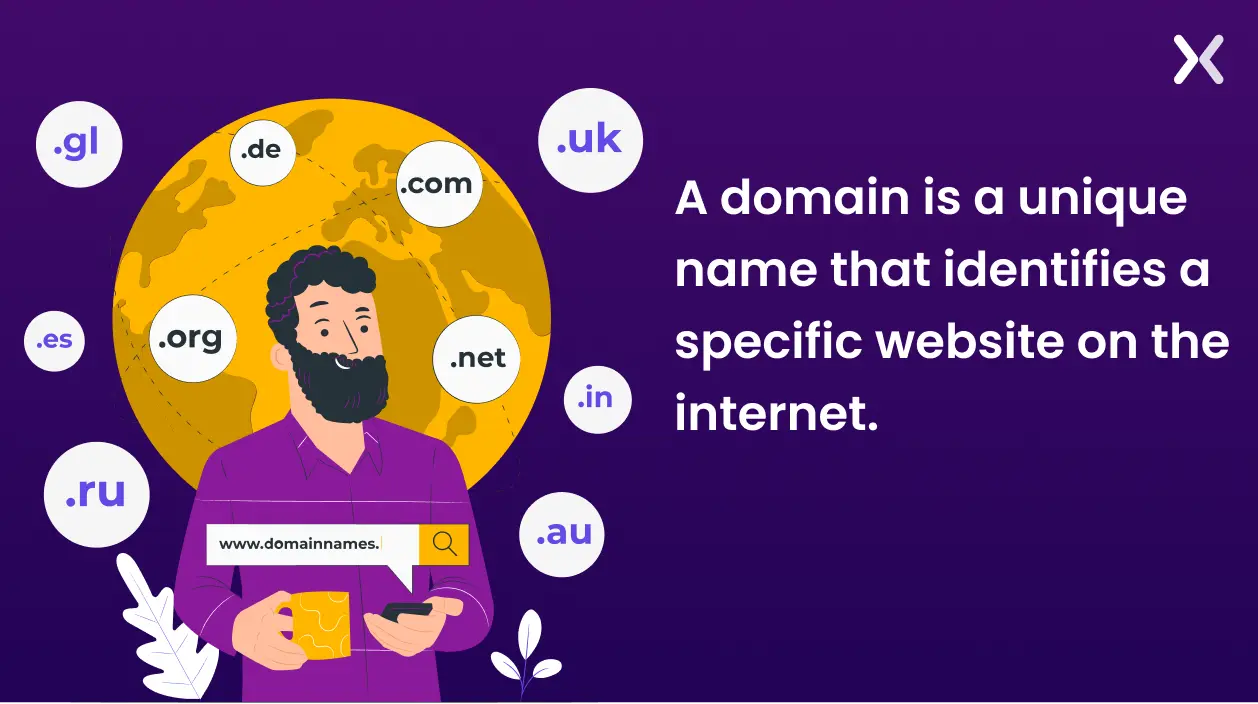
Think of your domain as your website’s virtual address. It’s the plot of land where your online presence resides. When people seek you out, they use your domain name to locate your website, making the internet far more user-friendly.
The domain name influences how consumers perceive your brand before seeing the website, so you must buy a domain name that reflects your brand.
Some examples of domain names are:
apexure.com
99landingpages.com
A subdomain is a subset of a larger domain. It’s a way to divide and organize different sections or services of a website under the same domain name.
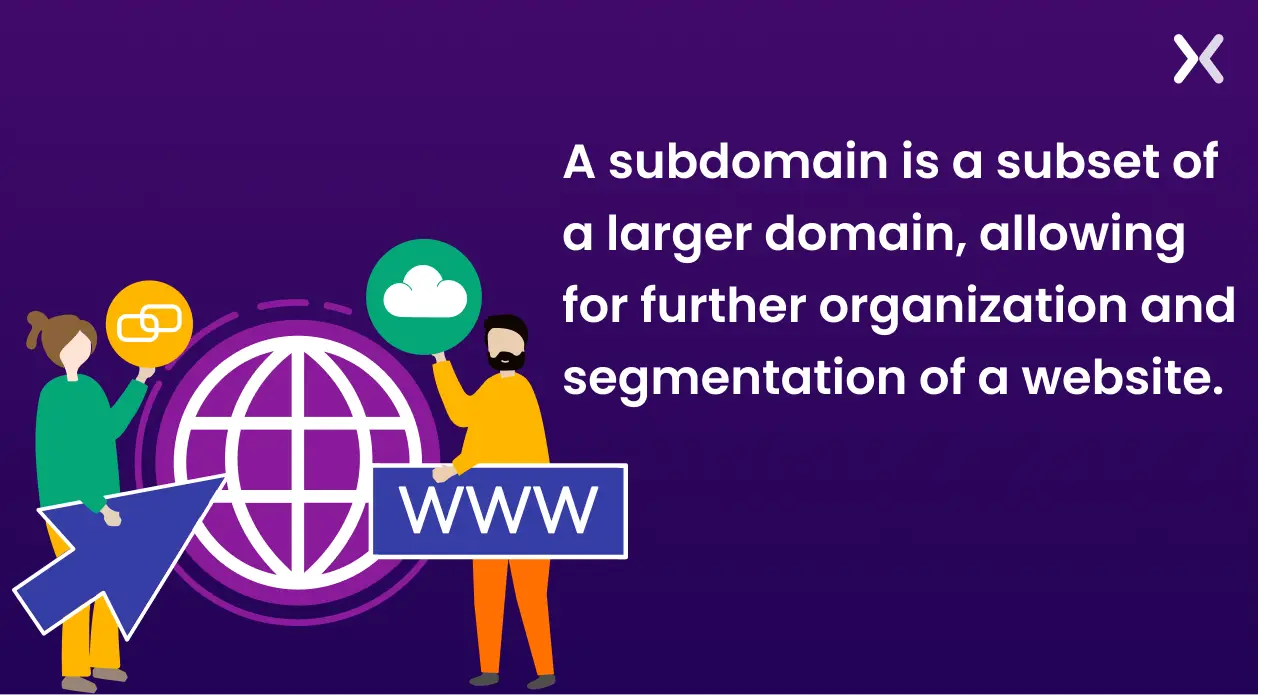
We use subdomains when a website needs to serve more than one function or an additional function. This could be because you want your root domain and your subdomain to be managed separately.
It could also be because your root domain doesn’t offer the necessary functionality. They can point to entirely different servers or hosting environments, allowing for more flexibility in managing different parts of a website or application.
Some examples of subdomain names are:
portfolio.apexure.com
99landingpages.com/blog/
Now we see two different formats for subdomain names. Don’t worry. We will discuss them right after we’re done covering the basics.
Let’s get into the details with some domain and subdomain examples.
You might own a cafe in London. You register the domain mycafe.co.uk, which will house all information about your retail outlet, such as operating hours, menu, and brand narrative.
Perhaps, eventually, you would also like to sell your coffee beans directly to consumers online. In this case, you would create a subdomain like shop.mycafe.co.uk.
If your cafe and online store are both doing well enough, you might decide to franchise. A part of your marketing strategy could be to produce more content. You could then start a blog about the coffee culture under the subdomain blog.mycafe.co.uk.
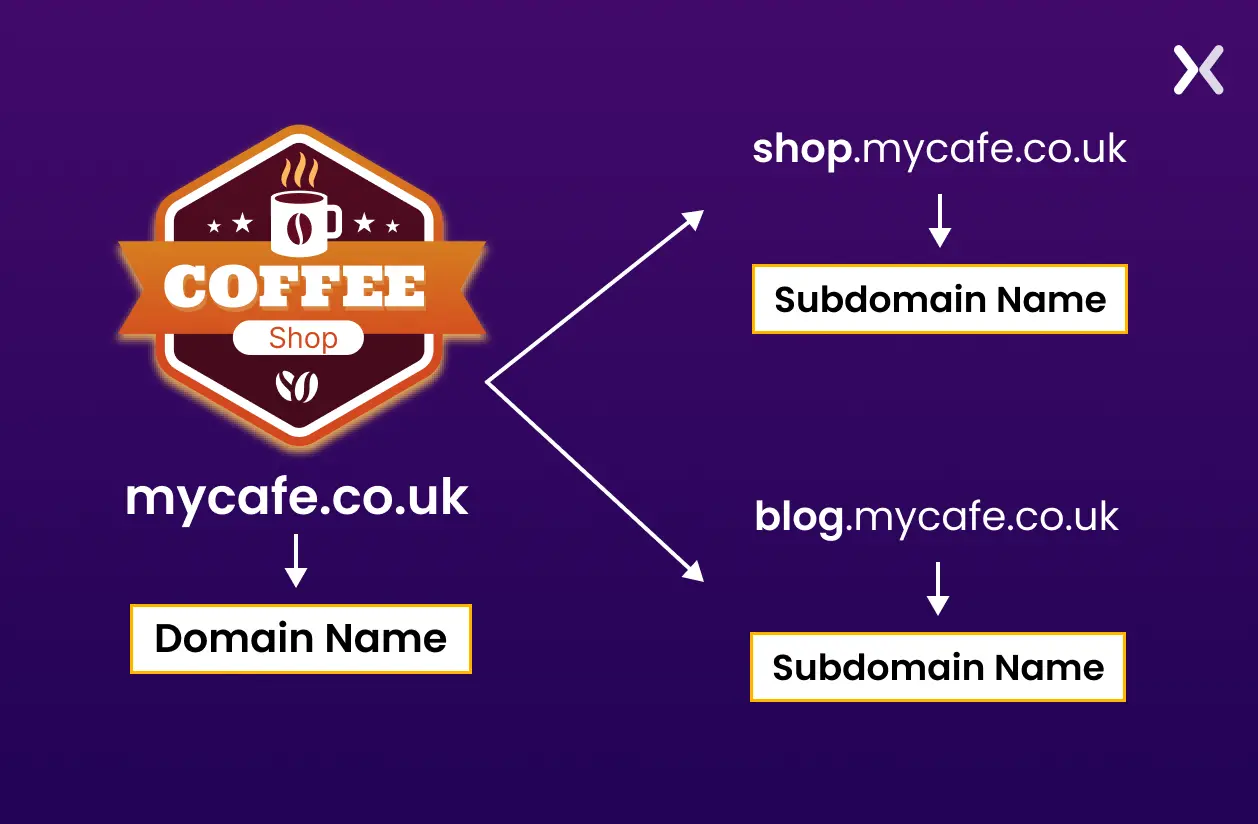
mycafe.co.uk - Domain Name
shop.mycafe.co.uk - Subdomain Name
blog.mycafe.co.uk - Subdomain Name
This is how domains and subdomains work.
For a great subdomain name, remember one thing: simplicity. Search engines see subdomains as distinct entities, but they should still have your brand name. Don’t make subdomains confusing with fancy names. Keep it simple to make it easy to understand and follow. Good subdomains help bring in more customers.
Let’s discuss some good subdomain examples:
1. portfolio.apexure.com
The URL of this subdomain is as clear as the sun. It’s obvious that it relates to Apexure’s portfolio.
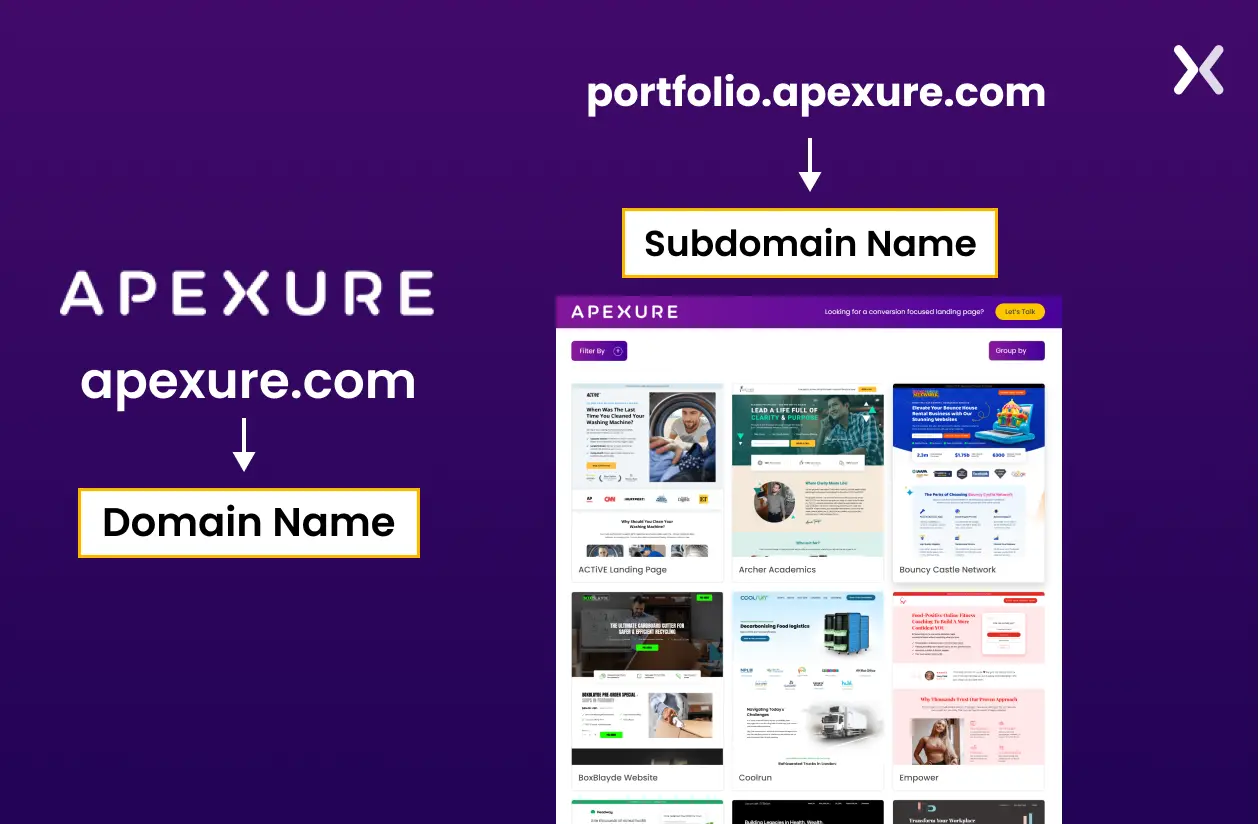
2. login.salesforce.com/
Once more, we can tell from the subdomain that this page is solely for logging into a Salesforce account.
3. help.zoho.com/portal/en/home
Here as well, based on the “help” section, we can infer that this subdomain relates to addressing user complaints or concerns.
Landing page subdomains are specialized subsections of a main domain that are dedicated to hosting landing pages.
Landing pages are designed for specific marketing campaigns, be it for SaaS, finance, or any other industry. They provide visitors with a focused place to take action, such as making a purchase or signing up. Because these pages prioritize conversions, they are crafted differently than regular website pages.
For instance, landing pages typically lack a header or footer with additional links. This intentional design keeps visitors focused on the page’s singular goal.
This is why subdomains are very handy tools for making a landing page. And just like your landing pages, don’t forget to host consistent, well-designed thank you pages—ideally on the same subdomain—for a seamless post-conversion experience.
Many marketers direct their PPC traffic to home pages, but that isn’t a smart play.
Let’s look at more landing page subdomain examples to demonstrate these points.
If your landing pages are intended for PPC ads, utilizing a subdomain is the optimal choice. However, if your goal is to enhance SEO, we recommend creating landing pages within a sub-directory of your domain rather than using a subdomain.
Subdirectories are divisions or folders within a website’s URL structure that contain related content or pages. They are represented by slashes (/) in a URL and follow the main domain name. For example: apexure.com/blog.
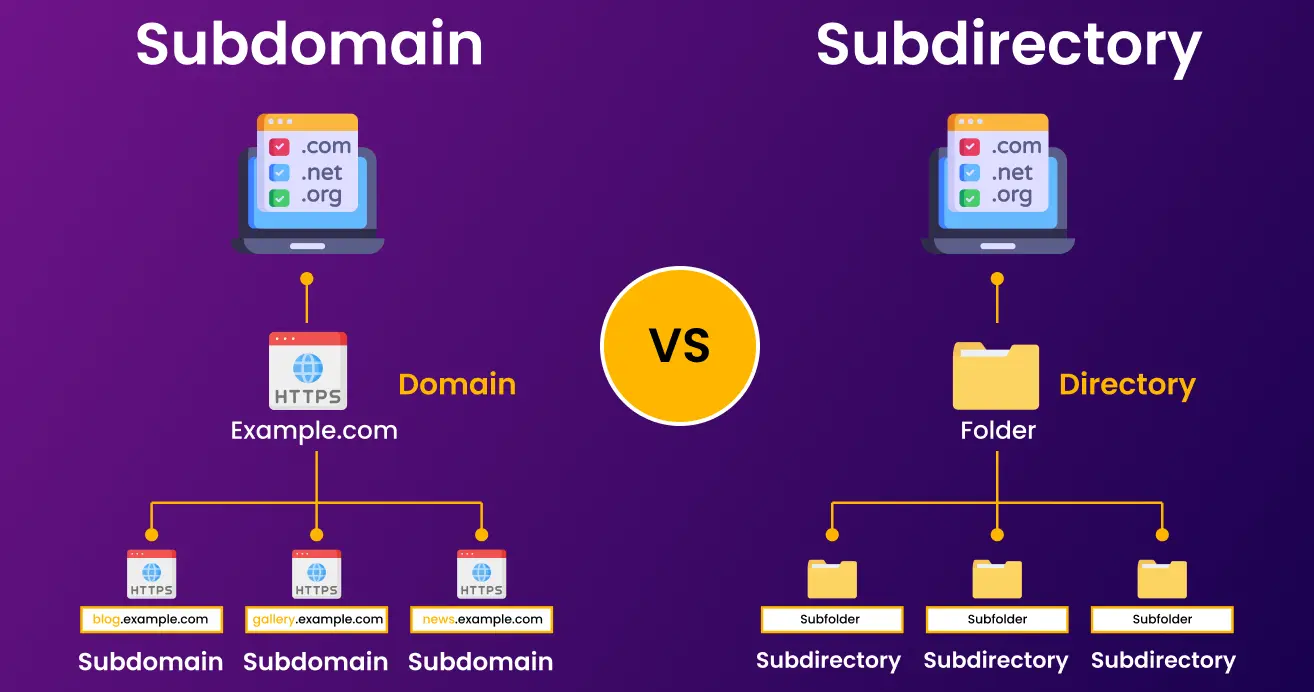
Subdirectories can enhance the ranking of your landing pages on search engine results pages (SERPs) by leveraging the strong domain authority of your main website. They offer fewer management challenges and provide a seamless branding experience. But you might have to make a few compromises on the design side.

Here are some landing page examples built on subdirectories:
www.zoho.com/crm/lp/everlasting-customer-relationships.html
www.zoho.com/crm/lp/lead-management-system.html
www.zoho.com/crm/lp/sales-management.html
Let’s break down one of these landing page subdirectory URL.
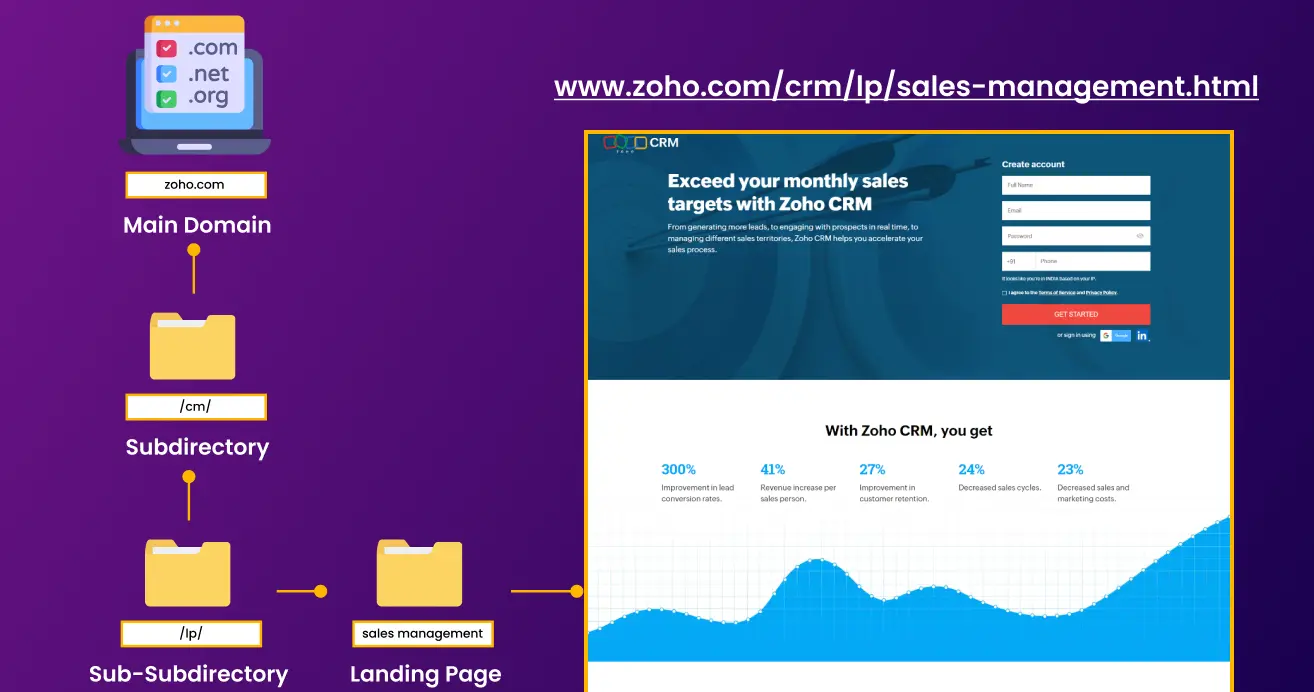
Let’s look at some more landing page subdomain examples to understand how businesses use subdomains for landing pages. These are specifically great if you have multiple landing pages.
It is a type of website set up where a single main domain hosts multiple subdomains, each dedicated to a different landing page. In this configuration, the main domain serves as the central hub, while each subdomain serves as a distinct entry point for specific marketing campaigns or promotions.
For example, consider a website for an e-commerce store:
Main Domain: example.com
Landing Page Subdomains:
promo1.example.com
promo2.example.com
promo3.example.com
Here, the main domain “example.com” represents the primary website, offering various products and services. Each landing page subdomain, such as “promo1.example.com” and “promo2.example.com,” is created for different marketing campaigns or promotions.
Each landing page subdomain provides targeted information and calls-to-action related to its respective campaign. By utilizing multiple landing page subdomains, the website can effectively promote various offers or initiatives without cluttering the main website or diluting its branding.
Here is a live example of the same:
Main Domain: taxfix.it/
Based in Italy, Taxfix is a mobile app that helps people file their taxes.
Landing Page Subdomains:
expats.taxfix.it/
precompilato.taxfix.it/
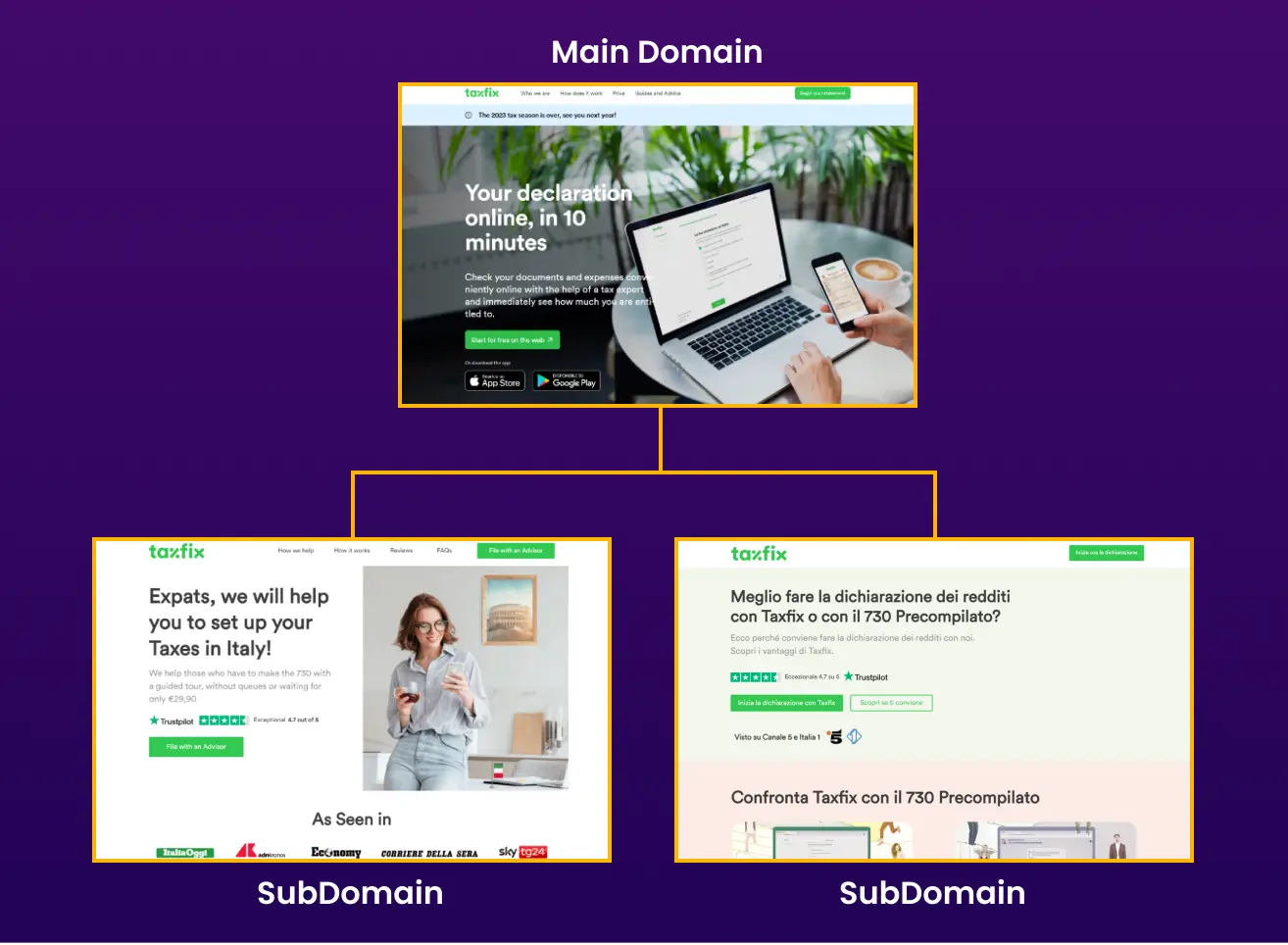
The two subdomains cater to distinct audiences and offer different promotions. Therefore, they are structured within the framework of multiple landing page subdomains on one domain.

In this framework, a single subdomain hosts several landing pages, each serving a specific marketing campaign or purpose. In this setup, the subdomain is a dedicated space for all landing pages related to particular aspects of the main website. The landing pages on the subdomain are distinguished with the help of subdirectories built on that subdomain.
Main Domain: example.com
Subdomain: services.example.com
Subdomain Subdirectory: /seo
Within the “services” subdomain, there are multiple landing pages:
services.example.com/seo
services.example.com/social-media
services.example.com/ppc
Here, the landing page subdomains define traffic coming from different sources, like SEO, social media, and PPC. The landing pages for all three campaigns can be completely different or have some differentiating elements like layout, copy, etc.
Here is a live example:
Main Domain: www.door3.com DOOR3 is an independent technology consultancy and software development firm based in NYC.
Subdomains: award-winning.door3.com
award-winning.door3.com/power-bi-dashboard-development/
award-winning.door3.com/ux-checklist/
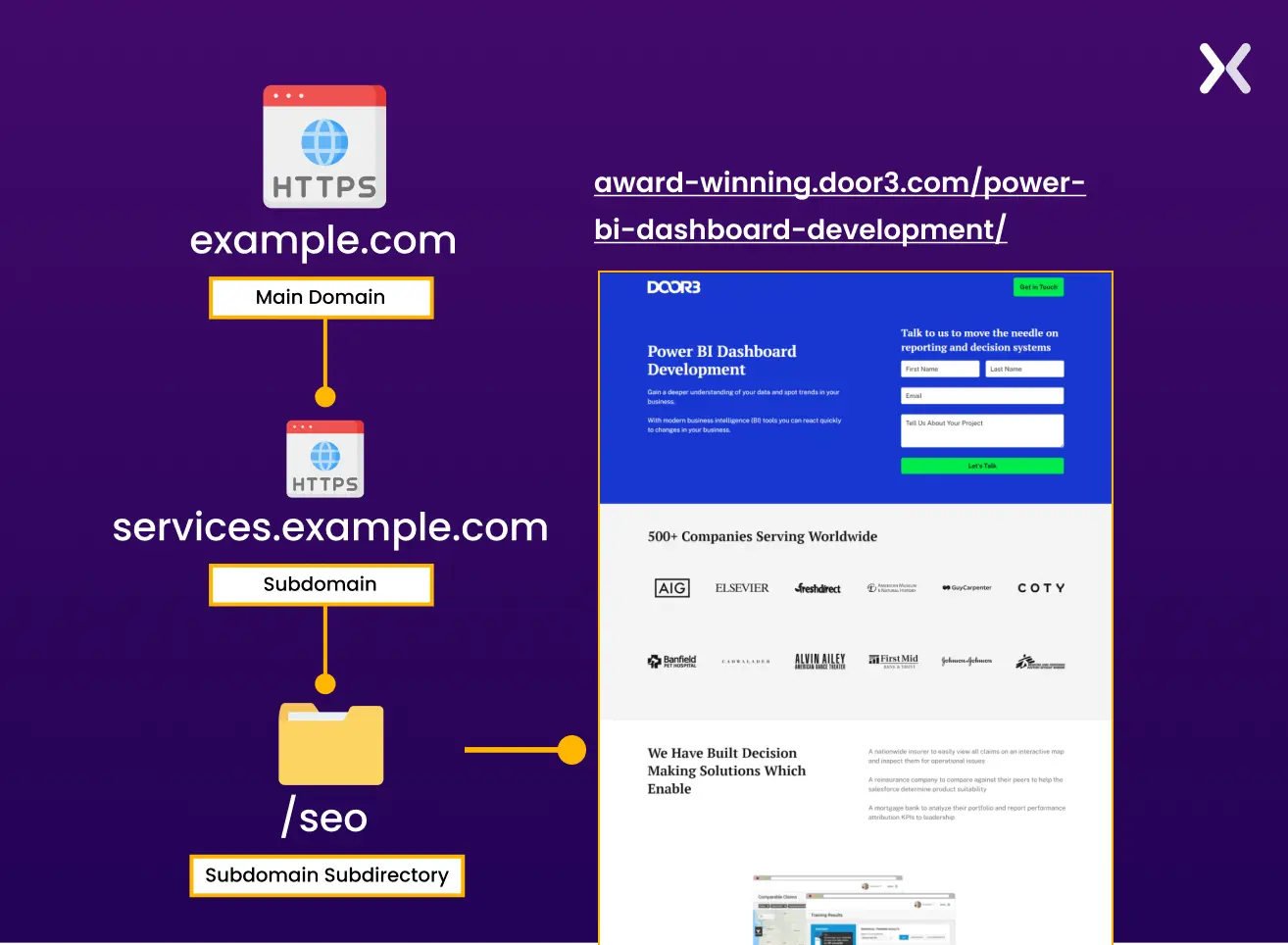
The landing pages on the domain serve distinct marketing campaigns. The power BI dashboard is for services provided by DOOR3, while the UX checklist offers a lead magnet.
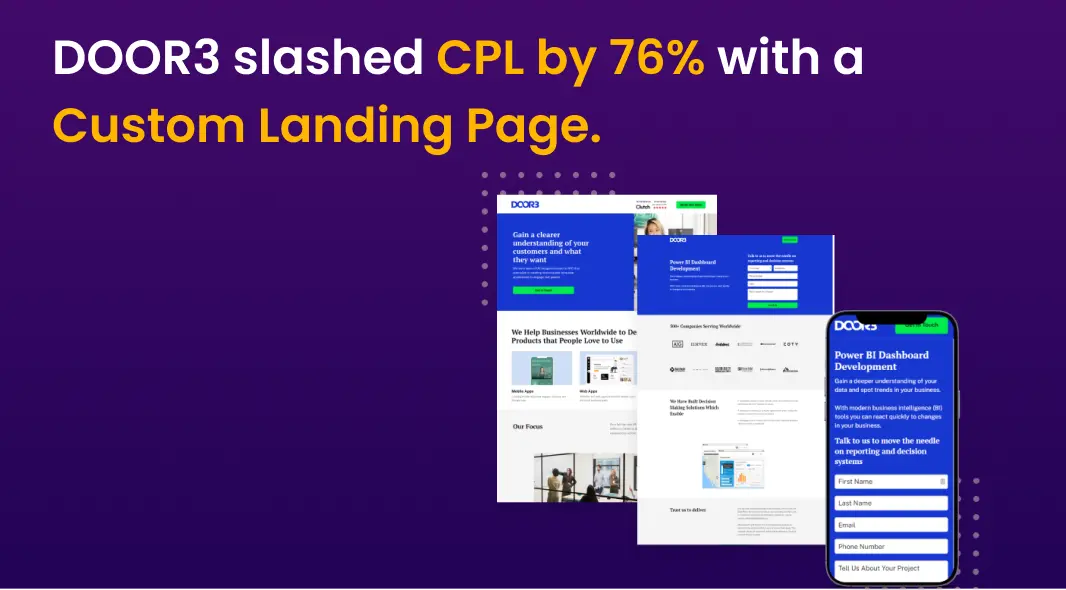

We can see when landing page subdomains come in handy with the above examples. But let’s talk more about why subdomains are so handy.
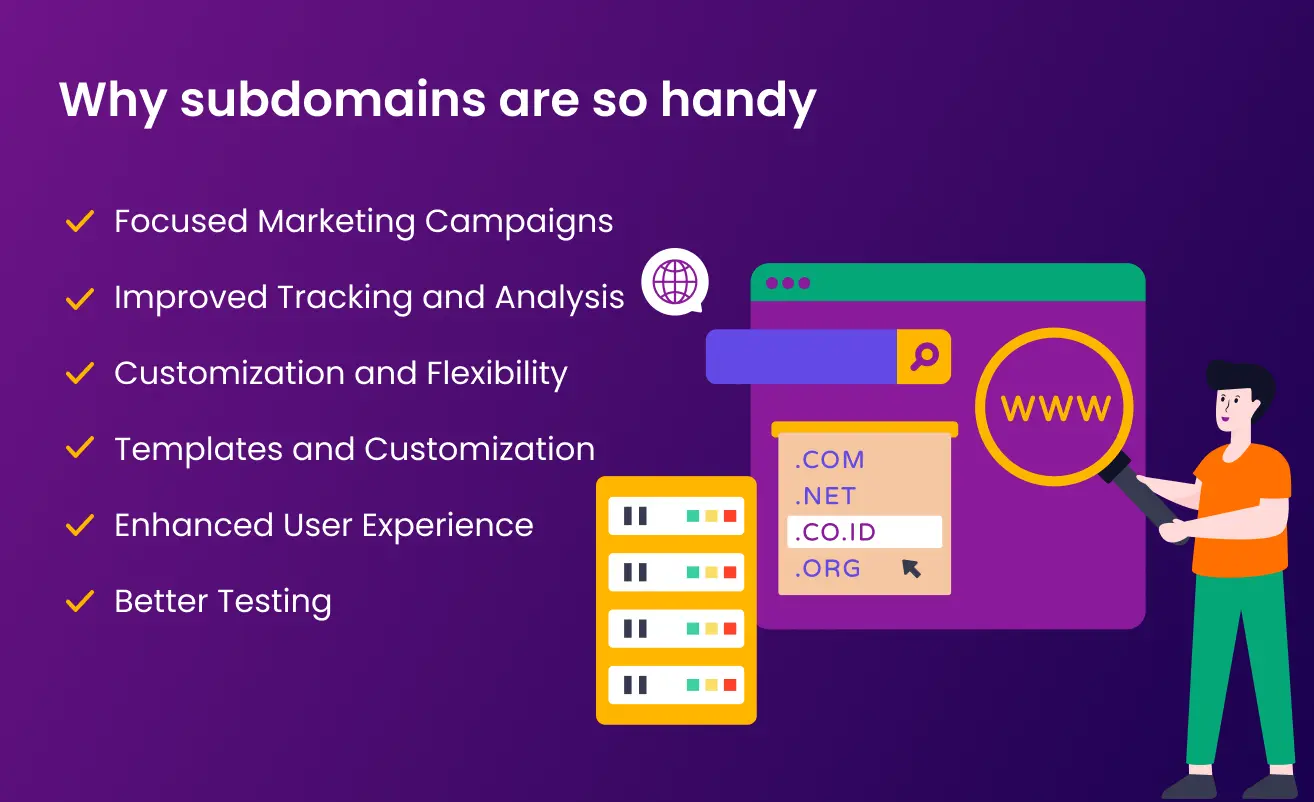
Landing page subdomains allow you to create dedicated pages for specific marketing campaigns or initiatives. It helps ensure that visitors are directed to a targeted message, increasing the likelihood of conversion.
By hosting landing pages on separate subdomains, you can easily track and analyze the performance of each campaign. The in-depth data provides valuable insights into what strategies are working and allows for optimization to improve your results.
Subdomains offer flexibility in terms of design and content, allowing you to customize each landing page. You can create landing pages to suit the unique requirements of different campaigns or target audiences without considering whether it will sit well with your website.
Landing page subdomains can provide a seamless and cohesive experience for visitors, as they are directed to pages specifically tailored to their interests or needs. It improves engagement and overall satisfaction for your marketing campaign, and you can watch the ROI soar high.
Utilize landing page subdomains to test different marketing campaigns or variations of landing pages. By creating separate subdomains for each test, you can easily compare their performance metrics and determine which approach yields the best results.
A landing page does not necessarily need its own domain. While having a unique domain for a landing page can be beneficial in some cases, it is not always required.
Using a subdomain for a landing page can provide a dedicated web address that is distinct from the main website, making it easy to share, promote, and track. It can also give the landing page a sense of independence and professionalism.
On the other hand, if you don’t have a domain, you can still build subdomain landing pages. You can sign up with landing page builders like Unbounce, Leadpages, etc. Such tools provide hosting for your subdomain landing pages.

“If you utilize a landing page builder such as Unbounce or Hubspot, your pages can be effortlessly created within the platform, alleviating the need to concern yourself with tracking, as it is seamlessly integrated into the tool itself.”
For example: Here is how you can create a subdomain landing page on Canva for free.
Once you’ve created your landing page, hit the publish button. Here, you have to choose the free domain option.
Now, give a suitable name to your subdomain landing page.
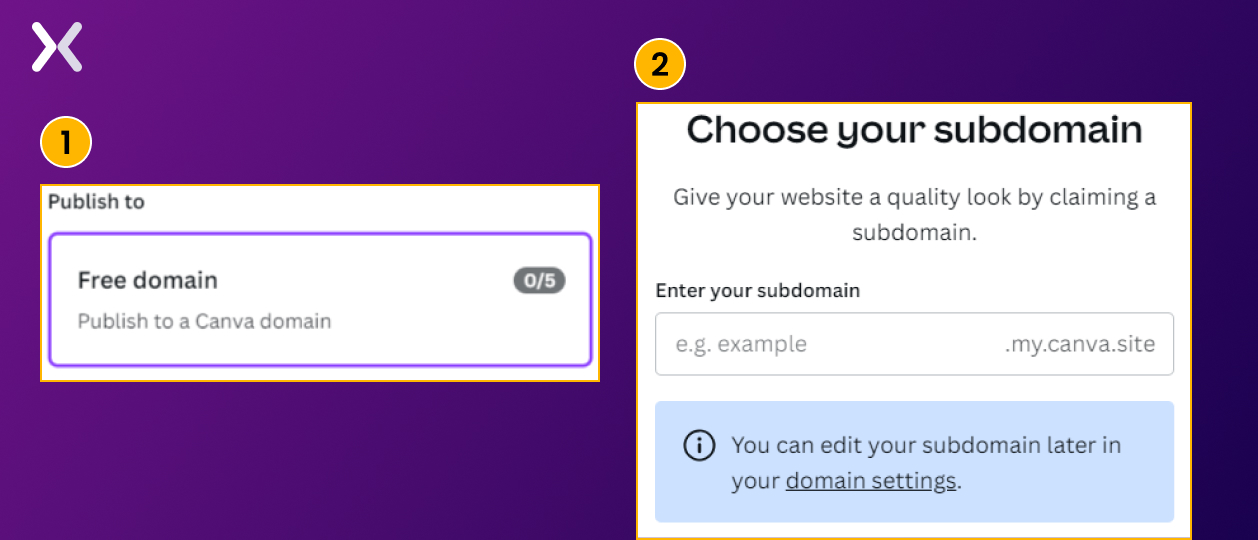
It is not over yet. You also have the option of creating a subdirectory within your subdomain here. It is not necessary to have it, though.
The best part here is the advance feature that allows you to hide your landing page subdomain from SERPs if you are focusing on PPC ads.
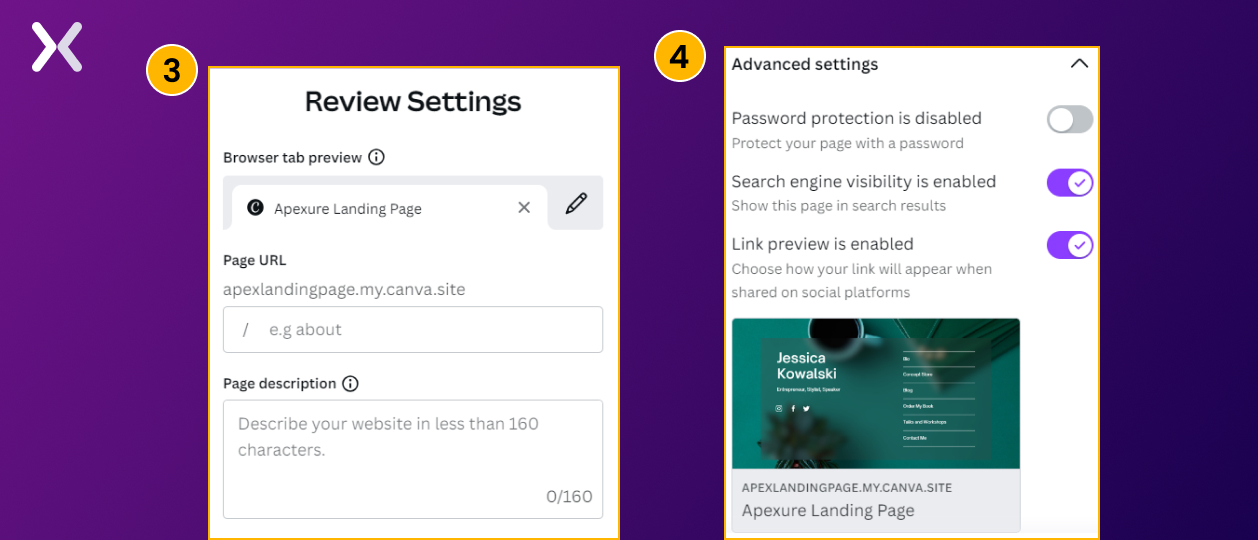
And here is how your landing page subdomain will look at the end. Here the subdomain is “apexlandingpage”
If you do want a subdirectory within your subdomain landing page, here is how it will look.
Subdomain: apexlandingpage
Main domain: my.canva.site
Subdirectory: macromania

Landing page subdomains offer a strategic solution for hosting PPC landing pages and other critical campaigns requiring additional details. With their ability to provide focused environments and tailored experiences, subdomains are valuable assets in optimizing conversion rates and enhancing marketing efforts.
By leveraging the advantages of landing page subdomains, businesses can effectively target specific audiences, track performance metrics, and streamline their online presence for maximum impact.
Whether it’s directing traffic for PPC campaigns or launching specialized initiatives, incorporating landing page subdomains into your digital strategy can significantly create a better web presence for your business.
Did you know that Apexure has our 100+ blog posts on landing pages. From creation to testing, analysis to optimization, we have shared everything. Check it out before your building your landing page.
Making a landing page on your own can be overwhelming. Get the help you need with our experts. Book a call and one of our landing page experts will contact you soon.
Check out our landing page portfolio to discover conversion-friendly landing page elements that might be missing from your campaigns. Filter your industry and check which landing page design is trending.
Using a subdomain for a landing page offers customization, isolation from the main site’s changes, improved tracking, better performance, and enhanced security.
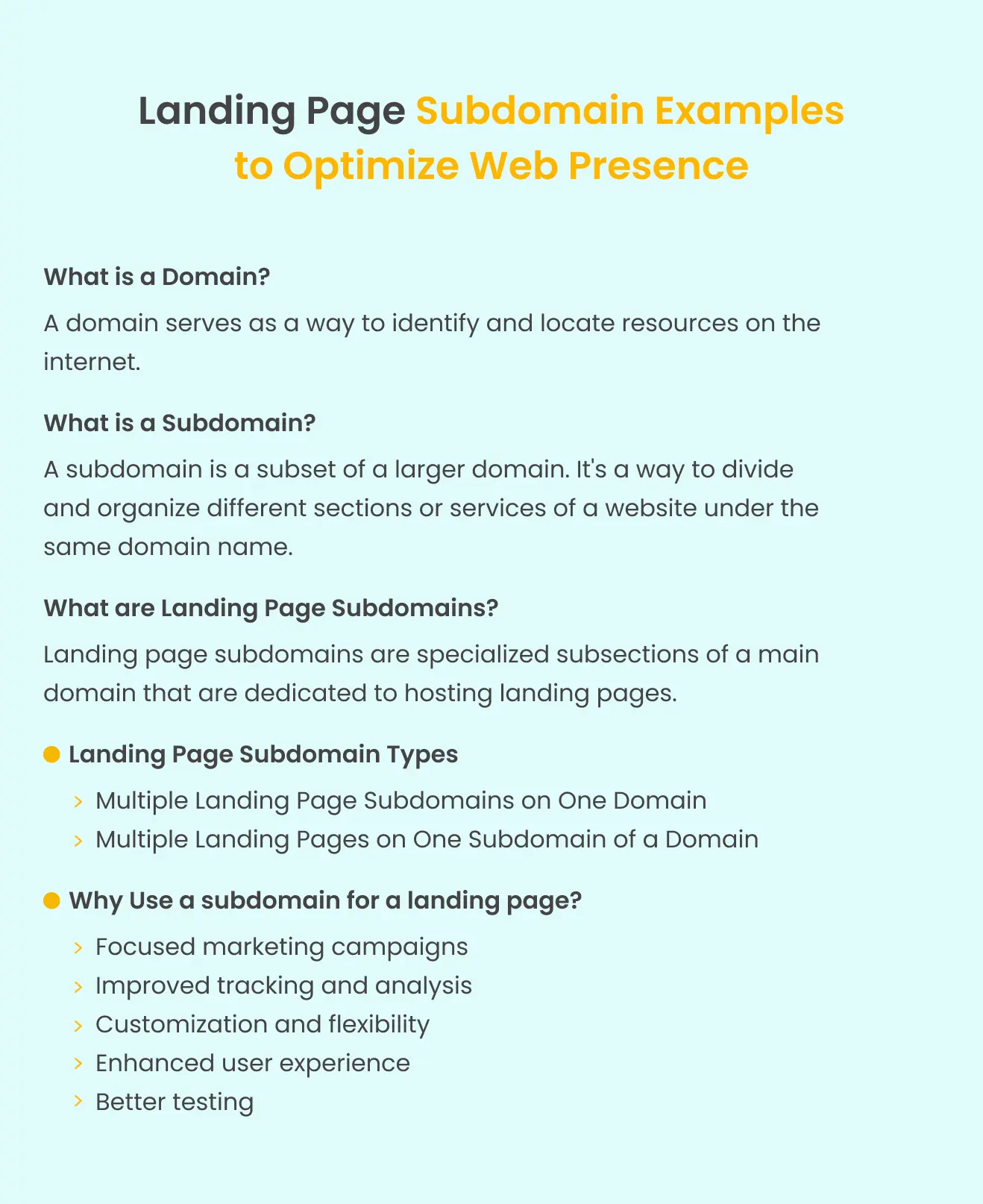
Related Articles:
Drive More Sales or Leads With Conversion Focused Websites and Landing Pages
Get Started.png)
In today’s fast-paced digital world, having a responsive website is no longer just a nice-to-have, it’s essential. Whether...
As artificial intelligence continues to evolve, businesses are finding innovative ways to enhance their marketing efforts. One of...
Get quality posts covering insights into Conversion Rate Optimisation, Landing Pages and great design